One of the joys of growing potatoes is the multitude of varieties available, from russets to reds and purples to yellows. With so many tempting choices, it’s natural to want to plant several different types in the same garden bed. But is combining multiple potato varieties in close proximity a good idea?
The short answer is yes, you can grow different potato varieties together, but with a few important caveats. By understanding potato plant biology and growth habits, we can make smart companion planting decisions.
Factors to Consider When Interplanting Potato Varieties
Several key factors determine if different spud varieties will thrive when planted in the same location:
-
Maturation rate – Early, midseason and late-maturing varieties should not be interplanted as their growth cycles won’t align.
-
Yield – High yield and low yield varieties can successfully be paired but may require tailored care
-
Height – Taller and shorter plants combined may lead to shading issues negatively impacting tubers.
-
Spacing – With adequate spacing between plants, competition is reduced.
-
Purpose – Salad, baking and storage potatoes have different soil nutrition needs.
As long as varieties with similar traits are chosen, interplanting can be successful with proper planning.
Best Practices for Interplanting Potatoes
Follow these tips to get a bountiful harvest when growing multiple potato types together:
-
Stick to 2-3 varieties with similar maturation rates and growth habits.
-
Use alternating rows rather than random mixing which makes crop-specific care difficult.
-
Space plants 12-18 inches apart and rows 2-3 feet apart to minimize competition.
-
Fertilize the soil preplant focusing on balanced nutrition for all varieties.
-
Hill all plants at the same time regardless of variety to prevent excessive shade.
-
Monitor for pests and disease and treat promptly to avoid spread between varieties.
-
Water thoroughly for even moisture and dig tubers of early varieties promptly to avoid disturbing later ones.
Compatible Potato Variety Combinations
Certain potato pairings or trios work especially well when interplanted. Some great examples include:
Early Season Varieties
-
Norland (red)
-
Superior (white)
-
Yukon Gold (yellow)
These all mature within 60-70 days and produce similar size plants around 12-18 inches tall.
Midseason Varieties
-
Kennebec (white)
-
Red Pontiac (red)
-
Viking (purple)
Maturing in 80-90 days, these make ideal companions with comparable habits.
Late Season Varieties
-
Russet Burbank (russet)
-
Purple Viking (purple)
-
Rose Finn Apple (yellow)
Taking 100 or more days to mature, these late crop potatoes will reach harvest together.
Is Interplanting Potatoes Always Advisable?
While interplanting spud varieties with similar traits often works well, some garden situations are better suited to planting just one potato type:
-
In cooler climates with a short growing season, choose a single early variety to ensure simultaneous ripening.
-
For novice gardeners, stick to one variety to avoid accidentally disturbing developing tubers of other types.
-
When growing in containers, select one variety adapted to pots for consistent water and nutrition needs.
-
To easily save potatoes for the next year’s seed stock, avoid potential cross-pollination between blossoms.
Embrace the Virtue of Patience
Part of the magic of gardening is learning what thrives through experience. Be patient with yourself and the potatoes! Pay close attention to plant performance when intercropping and fine-tune your pairing selections each season. With smart planning guided by observation, you can discover wonderful flavor combinations.

Watch This BEFORE You Plant Potatoes
FAQ
Can you mix different types of potatoes?
Can potato varieties cross-pollinate?
Can you plant regular potatoes with sweet potatoes?
Can I plant red and white potatoes together?
Can you grow potatoes with a companion plant?
Potatoes (Solanum tuberosum) are starchy tubers that are a great addition to your vegetable garden—you can grow unique varieties of potatoes that you may not find in the store and they keep in the pantry much longer than tender veggies. Companion planting can help maximize the efficiency and health of your garden potato crop.
Do potatoes grow together?
Because they often use the same nutrients, potatoes don’t enjoy being buddies with other root vegetables. These types of plants include carrots, turnips, parsnips, and radishes. Growing these plants together inhibits their growth and leaves you with a less-than-ideal harvest.
What are the different types of potato companion plants?
There are many types of potato companion plants, including vegetables, herbs, and ornamentals. Potatoes grow deep in the soil, so most companion plants will be those with above-ground growth habits that do not interfere with the potato tubers. Here’s a list of the best potato companion plants:
What plants grow well with potatoes?
For example, planting basil with tomatoes is believed to improve growth and flavor. There are many types of potato companion plants, including vegetables, herbs, and ornamentals. Potatoes grow deep in the soil, so most companion plants will be those with above-ground growth habits that do not interfere with the potato tubers.
How to grow various types of potatoes in a garden?
To grow various types of potatoes in a garden, potatoes require a chilling period before tubers can form, which is why most gardeners plant their taters in the late winter or early spring. Southwestern gardeners may even start their crops in the fall.
Can you grow potatoes in the same bed?
Tomatoes (And Other Members of the Nightshade Family) Potatoes are part of the same plant family as tomatoes, peppers and aubergines. The problem will growing potatoes close to or with other members of this family is that pests and diseases spread easily between them. Don’t grow them together, or plant them in the same bed following one another.
- The Ultimate Guide to Growing Strawberries in Raised Beds - August 8, 2025
- No-Dig Garden Beds: The Easiest Way to Grow a Beautiful Garden - August 6, 2025
- How to Protect and Preserve Wood for Raised Garden Beds - August 6, 2025
